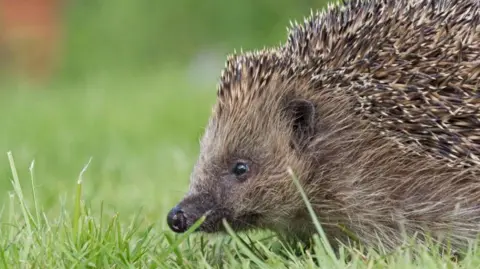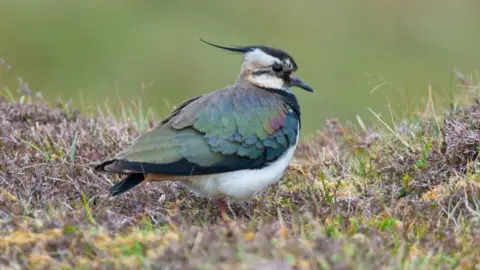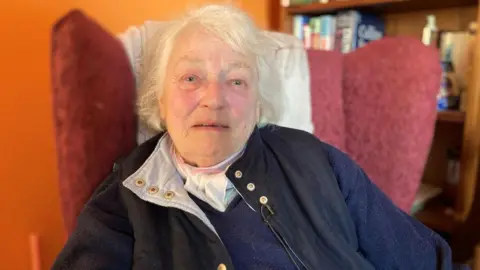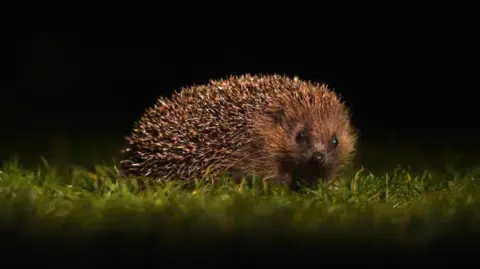How hedgehogs became a problem in the Hebrides
 Getty Images
Getty ImagesFifty years ago hedgehogs were reportedly let go into a garden in South Uist in the Western Isles in the hope they would eat slugs and snails.
In the years following 1974 numbers of the prickly creatures multiplied - and they were soon preying on more than garden pests.
By 2001 it was becoming such a problem an effort was launched to remove them
Why would hedgehogs be a problem in the Hebrides?
 Getty Images
Getty ImagesCelebrated by children's author Beatrix Potter through her character Mrs Tiggy-Winkle, hedgehogs are widely regarded as cute and cuddly (if you don't mind the jaggy spines).
They eat beetles, worms and slugs but they can also take the eggs and chicks of ground-nesting birds.
And there lies the problem for conservationists.
Hedgehogs are not native to the Western Isles, but the islands are home to thousands of ground-nesting birds, waders such as lapwing, curlew, dunlin and redshank.
Many of the birds are of high conservation concern and declines in the islands was detected in the mid 1980s.
By 1995 hedgehogs were common throughout South Uist and Benbecula, their numbers growing in part thanks to the lack of predators and not being run down on the isles' quiet roads.
Research done by NatureScot between 2012 to 2014 suggested 55% of monitored nests in South Uist, where hedgehog numbers were high, failed.
What action was taken against hedgehogs?
An initial plan to cull them was quickly abandoned due to a public outcry.
Instead, the Uist Wader Project - which involves public body NatureScot and charity RSPB Scotland - was set up to trap hedgehogs and relocate them to the mainland, after first being given a health check and then tagged.
Hessilhead Wildlife Rescue Centre in North Ayrshire has been among the groups helping out.
Since 2001, some 2,441 hedgehogs have been removed.
So, how do you catch a hedgehog?

Searches were often done at night when the animals were hunting for food.
During the course of the project, NatureScot staff has used sniffer dogs to find hedgehogs and has also set traps to capture them alive.
Volunteers such as Pat Holtham have also helped out.
She would shine a torch at a hedgehog and the animal would then stop moving as soon as it felt the slightest touch of a hand.
Mrs Holtham could then "grab them and bag them".

At the height of the project, Mrs Holtham set aside part of her garage in Uist to provide temporary accommodation to 44 hedgehogs and over the years has helped in caring for as many as 1,200.
"My love of hedgehogs is obsessive," she laughed.
"They are wonderful creatures and they are all different and have their own personalities. It sounds stupid to say that but it's true."
Mrs Holtham said she felt privileged to play a part in the project so far.
She added: "I'm getting withdrawal symptoms. I've not had a hedgehog for two years."
Has the project been successful?
Yes, according NatureScot.
It said hedgehogs had been removed from North Uist and predation of birds had been significantly reduced.
The agency said hedgehog populations were still found in Benbecula, South Uist, Harris and Lewis.
A spokesperson said: "There is no plan to remove hedgehogs from Lewis and Harris as there isn’t the same overlap between hedgehog habitat and the high density wader populations found on the Uists machairs.
"There have been no recent reports of a hedgehog from the North Uist area."
What next?
 Getty Images
Getty ImagesNature Scot said it was looking at future stages of the project and expected to have more news in the summer.
RSPB Scotland said: "While there is not presently any official monitoring being undertaken, hedgehog sightings remain common on Uist.
"We will be in a position to discuss the project development in more detail later this year, when we will be holding a community talk as part of the Outer Hebrides Wildlife Festival in June/July.
"We would encourage anyone who is interested to come along to find out more information."
